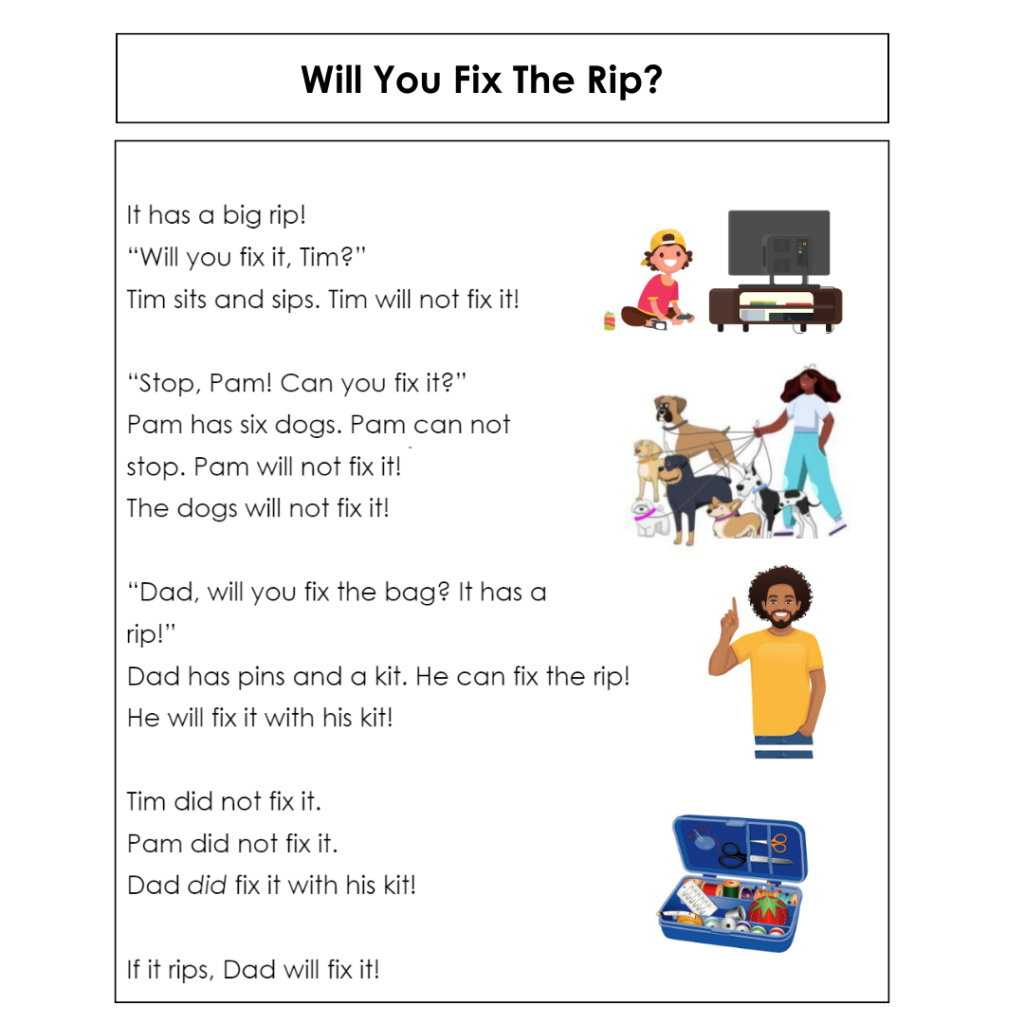We love finding a Netflix or Prime series that we can count on – one that gives us something to think about after watching as well as something to look forward to in the next episode. In the same way, we hope that you find this “Decodable Text: Questions and Answers” series provides something for you to think about and something to anticipate.
If you’re new to this blog series completely, you can “binge-read” from the beginning by starting here.
In our last “episode,” we followed the trials and tribulations of a youngster in search of a solution for repairing a bag with a big rip!
Wondering how the story turned out? You can catch up here, where we – along with the help of the boy and the ripped bag – explored the question:
- How do I know if a text provides the right mix of words for my students?
In this post, we continue to follow the ripped-bag drama by exploring the questions:
- What about meaning-making in decodable texts?
In our last post, we introduced the idea that evaluating decodable texts really comes down to two primary considerations – the words and the meaning – and then we zoomed in on the first of them, THE WORDS.

And today, we’ll use that same text again, this time looking at it through the lens of MEANING.
You can download a copy of Will You Fix the Rip? here.
THE MEANING: What about meaning-making in decodable texts?
Concerns that decodable texts are often devoid of much meaning or even nonsensical drove many of us away from decodable texts in the past. And even though there are now more decodable texts available than ever, many of them still read like tongue-twisters and/or are hard to make much sense of.
But, even in simple, decodable texts, it’s still important to expect that students will have something meaningful to think about and talk about. The good news is that more and more well-written decodable texts are available than ever. And the search for strong texts to share with children is worth the effort. After all, reading is about meaning-making, and we want children to make a habit of thinking about each text they read, right from the very start, even in the simplest of texts.
Of course, we know we can’t count on simple, decodable texts to carry all the weight of comprehension, knowledge building, and vocabulary development. Interactive read-aloud texts are our main tool for that. But even so, we shouldn’t count simple texts out when it comes to providing kids with things to think and talk about.
As we thought about the simple text, Will You Fix the Rip? these are questions we could see ourselves using to engage children in conversation and thinking. As you read through these questions, notice how much thinking a relatively simple text can potentially stimulate.
- How are bags used, and why does it matter if they are ripped?
- Who do they think is telling the story?
- Why won’t Tim fix the bag?
- Why can’t Pam fix the bag?
- What is the difference between being unwilling to fix the rip (Tim) and being unable to fix it (Pam)?
- What is a kit?
- How will Dad fix the rip?
- How do you think the narrator feels about each event in the story?
Of course, we wouldn’t take the time to ask this many questions in one encounter with a decodable text. That would steal too much precious time away from students actually reading the text. But we hope you see that simple, decodable texts can be written in ways that don’t require us to close the door to thinking and conversation.
So, as you are examining decodable texts, here are some things to ask yourself about the story or content, keeping in mind that decodability is important–but not enough–to make a text worth your students’ time.
- What is there to think and/or talk about during and after reading the text?
- What inferences will children get to make?
- How might they retell or summarize the content? (Note that, If it’s not possible to summarize or retell–i.e., there is no cohesive structure–something is definitely off with the text.)
Remember, the need to control the words in decodable texts will limit how complex the text can be. However, the storyline, information, and pictures can add meaning without detracting from the decoding practice. Photos or illustrations, of course, can also add engagement, which is an important aspect of meaning.
Engagement is last, but certainly not least, in today’s conversation about reading for meaning, even in the beginningest texts.
Maybe you are wondering, “But aren’t decodable texts just really boring?”
Well, some are. And some aren’t. Here are some things to consider as you evaluate how a decodable text may (or may not) appeal to students.
- What makes the story or information interesting?
- What will draw children in?
- What might make students smile, laugh, question, wonder, argue, predict, or otherwise read actively?
- What will students find relatable in the text?
Of course, diverse and affirming representation is not only possible but critically important, even in the simplest of texts. So you will want to consider,
- Who is centered in the text?
- Who is left out?
- What lived experiences are valued?
As we consider the content of the text, Will You Fix the Rip? there are a number of things that we think make it appealing.
- It centers on a situation almost every child has some prior knowledge or experience with–having a beloved item that has been damaged and/or trying to find someone who can help you solve your problem.
- It offers some relatable humor–Tim is too distracted sipping a soda and playing video games. Pam would like to help but has her hands full with walking six canines. They won’t even stop, let alone help.
- It sets up a satisfying, and possibly unexpected, ending–Dad to the rescue with a sewing kit!
- Its sequential structure lends itself to a simple retelling–First, next, finally.
- It is easy to imagine ways to draw children into a conversation about the text using some of the questions listed in the previous section.
Writing excellent, simple, decodable texts for beginning readers has its challenges, but it is certainly possible. And the more we insist on better texts, the more those who are producing them will rise to our demands. So taking the time to evaluate the quality of texts–the WORDS, the MEANING–as you work to build your collection is time and effort that will benefit your readers in the long run.
So, grab a few decodable texts and dig in. Once you start to find excellent texts that are aligned with students’ skills and that engage them in powerful ways, it is hard to settle for less.
We’ll see you back here when we continue our conversation by exploring creative ways to get more decodable texts in children’s hands, even without a big budget. We hope you’ll stay tuned.
Binge our entire 6-part blog series about decodable texts!
Decodable Texts Q&A (Part 1): What? Why? Who?
Decodable Texts Q&A (Part 2): How Many is Enough?
Decodable Texts Q&A (Part 3): What to Look For? The WORDS.
Decodable Texts Q&A (Part 4): What Else to Look For – The MEANING.
Decodable Texts Q&A (Part 5): What About FREE Decodables?
Decodable Texts Q&A (Part 6): More Ideas for Getting Started!
-

Jan Burkins and Kari Yates are authors, speakers, and consultants, who are dedicated to helping teachers around the world translate reading science into simple instructional moves that help teachers make learning to read easier for their students while still centering meaning-making, engagement, and joy.
Recent Posts


